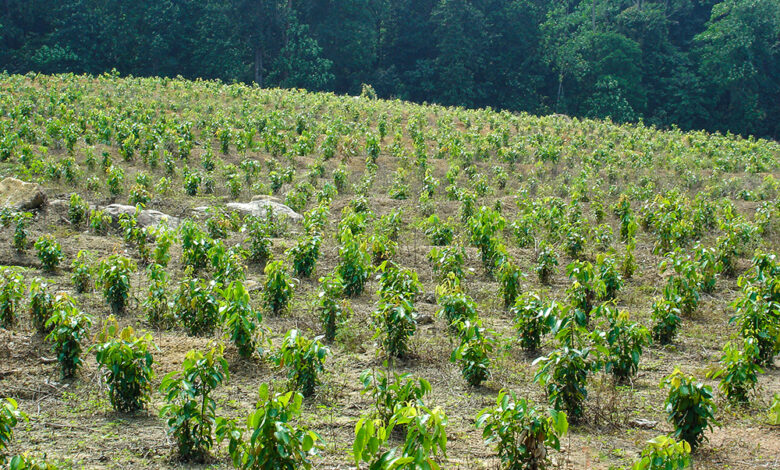
Cinnamon is one of the oldest known spices and has been an important part of Indian culture, cuisines, and traditional medicines. The plant from which cinnamon originates is the cinnamon tree, scientifically called ‘Cinnamomum’. It falls under the Lauraceae family. Because of the favourable climatic conditions, it is mainly grown in south Indian states like Kerala, Tamilnadu, and Karnataka.
This spice is the dried inner bark of trees belonging to the Cinnamomum genus. People use it as an aromatic spice and flavouring agent in sweet and sugary foods, snacks and cereals, sweets, tea etc. The two compounds found in cinnamon, cinnamaldehyde and eugenol, are responsible for the odour and taste of cinnamon. Besides, it is well appreciated for its use in traditional medicines.
Considering becoming a cinnamon farmer? You can read the blog below to get all the information related to cinnamon farming.
Top Cinnamon Growing States in India
As we already know, cinnamon is mostly cultivated in the southern states of India. Let’s check the top-producing states of this spice below.
- Kerala
- Tamil Nadu
- Karnataka
- Andhra Pradesh
- Maharashtra
Types of Cinnamon in India
India mainly grows two basic types of cinnamon. Cinnamomum verum, commonly referred to as the ‘true cinnamon or Ceylon cinnamon,’ and Cinnamomum cassia, also known as Cassia or Chinese cinnamon. While Ceylon cinnamon has a lighter tasting profile and health properties, Cassia is stronger and much more common. As we have seen, both varieties are unique and can be used for different purposes in cooking and medicine.
Different Names of Cinnamon in India
In India, cinnamon is also called by various names. These names are provided below in the table for reference.
| Cinnamon Names in India | |
| Dalchini | Lavangapattai |
| Karuvapatta | Darushila |
| Dalachina Chekka | — |
Cinnamon Benefits
Cinnamon is famous for its medicinal properties for decades. You can check its benefits below.
- Rich in antioxidants
- Have anti-inflammatory properties
- Good for heart health
- Can improve insulin sensitivity
- Can reduce blood sugar levels
- Have anti-cancer properties
- Can cure bacterial and fungal infections
- Good for skin
- Can cure toothache
Processes in Cinnamon Farming
Various processes are there in the cinnamon farming. These include soil, weather conditions, irrigation, pest control methods, and harvesting etc. If you are planning to start cinnamon farming, you can read about its important steps below.
Climatic Conditions
- Cinnamon plants grow best in warm, tropical regions. The perfect temperature for this farming is 20°C to 30°C.
- These plants should receive an annual rainfall of 2000 to 2500 mm.
- This spice prefers high-humidity areas and is sensitive to frost and prolonged chilled temperatures.
- Farmers should protect these plants from strong winds as they can damage the plant.
Preparation of Soil
- The soil used in the farming should have good drainage. The ideal pH of this soil should range from 5. 5 to 7. 0.
- One can plant cinnamon in sandy loam or clay loam soils.
- Farmers will need to til the land through ploughing or digging to a suitable depth of at least 12-18 inches. For this, the Mahindra 585 DI is one of the highly sought after tractors in the market. It is a powerful 50-hp tractor that is incorporated with different modern technologies. This tractor is famous for its low maintenance cost, small requirement for fuel and great braking capabilities. This can even perform heavy-duty tasks on the farm.
- They should mix organic fertilizers into the soil to improve its fertility.
Irrigation Systems:
- In the first year, farmers should water the plants 2-3 times to establish strong root development.
- They should water the mature plants once every 7-10 days. The drip irrigation method is perfect for this farming.
Pest and Diseases Management:
Leaf spot, shoot borer, caterpillar, termites, red ants, and coffee red borer are some of the common pests and diseases of this spice. If the farmer timely controls these pests and illnesses, it will ensure a good-quality cinnamon yield. To keep off them, growers can use natural predators and pesticides.
Harvesting Period:
The harvesting time of cinnamon begins in the monsoon season, typically from June to September. During the high humidity periods, it is easier to strip the bark from the tree. After collecting these barks, farmers dry them. Once they dry, growers send them to processing units. For transportation, they can use a Mahindra Novo 655 DI tractor. It is famous for its versatile agricultural applications. You can also attach a trailer in it to collect cinnamon from the trees. It can even carry 2700 kg of weight. Its price starts from 10,42,715 and goes up to ₹ 11,28,850 in India.
Conclusion:
In conclusion, cinnamon farming in India is a vital agricultural activity that intertwines historical significance, economic benefits, etc. With its rich heritage and potential for growth, the cinnamon industry continues to be a cornerstone of India’s spice economy. It offers prospects for sustainable development and global trade.



